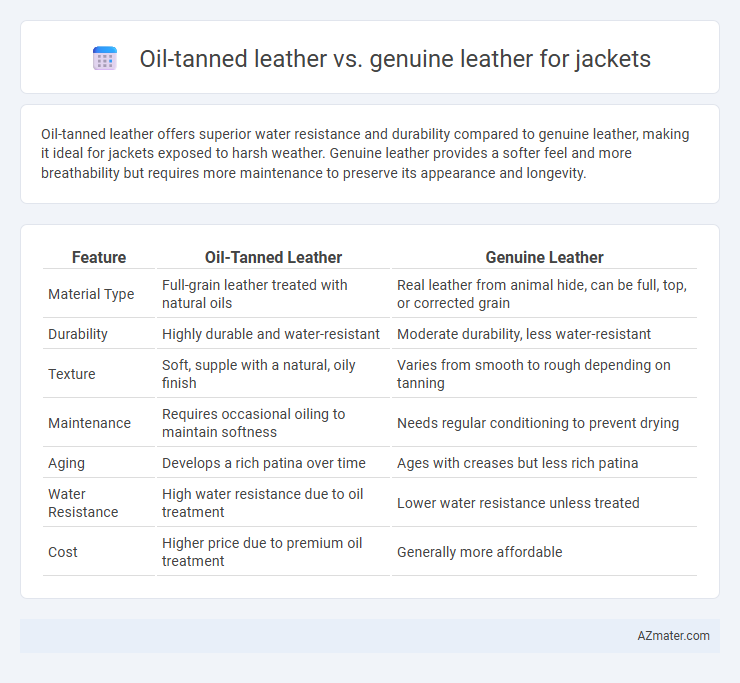Oil-tanned leather offers superior water resistance and durability compared to genuine leather, making it ideal for jackets exposed to harsh weather. Genuine leather provides a softer feel and more breathability but requires more maintenance to preserve its appearance and longevity.
Table of Comparison
| Feature | Oil-Tanned Leather | Genuine Leather |
|---|---|---|
| Material Type | Full-grain leather treated with natural oils | Real leather from animal hide, can be full, top, or corrected grain |
| Durability | Highly durable and water-resistant | Moderate durability, less water-resistant |
| Texture | Soft, supple with a natural, oily finish | Varies from smooth to rough depending on tanning |
| Maintenance | Requires occasional oiling to maintain softness | Needs regular conditioning to prevent drying |
| Aging | Develops a rich patina over time | Ages with creases but less rich patina |
| Water Resistance | High water resistance due to oil treatment | Lower water resistance unless treated |
| Cost | Higher price due to premium oil treatment | Generally more affordable |
Introduction to Leather Types in Jackets
Oil-tanned leather features a unique waterproof finish achieved by infusing natural oils into the hide, making it highly durable and ideal for rugged jackets. Genuine leather, derived from lower-grade hides or layers beneath the top grain, offers a more affordable option but with less durability and a smoother, less textured surface. Both types influence the jacket's longevity, appearance, and weather resistance, making choice dependent on intended use and style preferences.
What is Oil-Tanned Leather?
Oil-tanned leather is crafted by infusing hides with a mixture of oils and waxes during the tanning process, resulting in a durable, water-resistant material with a rich, rugged texture ideal for jackets. Genuine leather, by contrast, refers to any real leather made from animal hide, but it often lacks the specialized treatment that gives oil-tanned leather its distinctive toughness and weatherproof qualities. Jackets made from oil-tanned leather offer enhanced longevity and a unique patina that improves with wear, making them preferred for outdoor and heavy-duty use.
Understanding Genuine Leather
Genuine leather, crafted from natural animal hides, undergoes processes such as tanning to improve durability and flexibility, making it a popular choice for jackets. Compared to oil-tanned leather, genuine leather usually has a smoother texture and a more uniform appearance but can be less water-resistant and require more maintenance. Understanding genuine leather's unique properties helps consumers choose jackets that balance aesthetic appeal with durability and comfort.
Key Differences Between Oil-Tanned and Genuine Leather
Oil-tanned leather features a unique finishing process that infuses oils into the hide, creating a water-resistant surface with a supple, rich texture ideal for durable jackets. Genuine leather, derived from the lower layers of the hide, offers a more affordable option but lacks the same natural oils and often requires additional treatment to improve water resistance and longevity. Key differences include oil-tanned leather's enhanced durability, natural moisture protection, and distinct patina development compared to the more processed and less resilient nature of genuine leather jackets.
Durability Comparison for Jackets
Oil-tanned leather offers superior durability for jackets due to its unique treatment process that infuses natural oils deep into the hide, enhancing water resistance and flexibility while reducing the risk of cracking. Genuine leather, while authentic, typically undergoes less intensive processing and may show wear faster under harsh conditions or repeated use. For jackets subjected to rugged environments, oil-tanned leather maintains strength and patina longer, making it a preferred choice for durability-conscious consumers.
Comfort and Wear Over Time
Oil-tanned leather offers superior softness and develops a unique patina over time, enhancing comfort and durability for jackets. Genuine leather provides moderate breathability and firmness initially but may stiffen and show wear more quickly. Jackets crafted from oil-tanned leather maintain supple flexibility and resist cracking, ensuring long-lasting comfort compared to standard genuine leather options.
Maintenance and Care Requirements
Oil-tanned leather requires minimal maintenance due to its dense, wax-infused surface that naturally resists water and stains, making it ideal for outdoor jackets. Genuine leather demands regular conditioning and protection from moisture to prevent drying and cracking, especially when exposed to varying weather conditions. Both types benefit from occasional cleaning with a damp cloth, but oil-tanned leather's durability reduces the frequency and intensity of care needed.
Price and Value Considerations
Oil-tanned leather jackets typically command higher prices compared to genuine leather due to their specialized treatment process that enhances durability and water resistance. While genuine leather jackets are more affordable and offer classic aesthetics, oil-tanned varieties provide superior long-term value by developing rich patinas and maintaining structural integrity over time. Consumers seeking investment pieces often prioritize oil-tanned leather for its blend of rugged style and enhanced longevity, justifying the initial premium cost.
Style and Aesthetic Appeal
Oil-tanned leather offers a rich, rugged texture with a natural patina that deepens over time, enhancing the jacket's vintage and rustic aesthetic. Genuine leather jackets provide a more uniform and polished appearance, catering to sleek and classic styles. Both materials boast durability, but oil-tanned leather stands out for its unique, worn-in character that adds a distinct personality to each jacket.
Which Leather is Best for Your Next Jacket?
Oil-tanned leather offers superior water resistance, durability, and a rich patina that develops over time, making it ideal for rugged, long-lasting jackets. Genuine leather, while versatile and often more affordable, varies widely in quality and generally requires more care to maintain its appearance and longevity. For a jacket combining toughness and style, oil-tanned leather outperforms genuine leather in both performance and aesthetic appeal.

Infographic: Oil-tanned leather vs Genuine leather for Jacket
 azmater.com
azmater.com